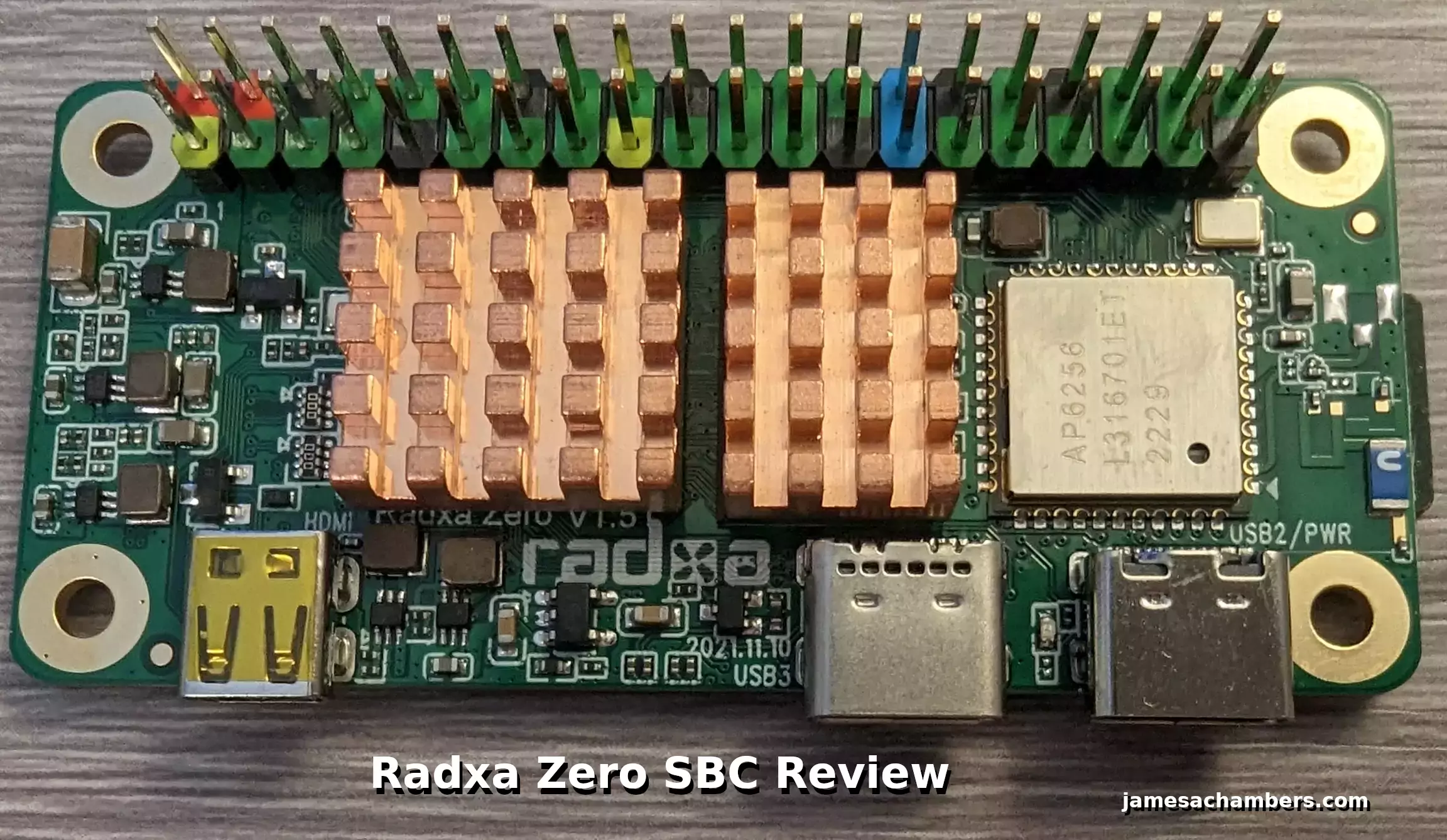
The Radxa Zero has been extremely popular since release and is still pretty hard to find on many major retailers. After trying to get it from a couple of different places I finally received mine this week!
In this review we’ll dive into using the Radxa Zero including the available images, hardware capabilities and what kind of performance to expect. Will the Radxa Zero live up to how popular the board seems to be and how hard it is to get?
Let’s find out!
Hardware Used

The Radxa Zero comes in the form factor of the Raspberry Pi Zero but is upgraded to USB-C and a quad-core CPU. Available with RAM options of 1/2/4GB and eMMC options of 8/16/32/64/128GB.
Links: AliExpress*, Amazon.co.uk*, Amazon.de*, Amazon.es*, Amazon.fr*, Amazon.it*, Amazon.nl*, Amazon.pl*, Amazon.se*
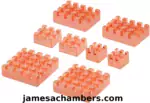
The Geekworm copper heat sink set is designed to fit many different single board computers. It uses thermal conductive adhesive which many “cheap” heat sink kits for SBCs don’t have. Eliminates hot spots and reduces throttling. Can be further enhanced by powered cooling over the heat sinks.
Links: Amazon.com*, Amazon.ca*, Amazon.co.jp*, Amazon.co.uk*, Amazon.de*, Amazon.es*, Amazon.fr*, Amazon.it*
Specifications
- CPU: Amlogic S905Y2 64bit quad core processor Quad Cortex-A53, 1.8GHz, 12nm
- GPU: Mali G31 MP2 GPU, supports OpenGL ES 1.1 /2.0 /3.1 /3.2, Vulkan 1.1, Open CL 1.1 1.2, 2.0 Full Profile
- Memory: LPDDR4 64bit dual channel LPDDR4@3200Mb/s, 1/2/4GB
- Storage: eMMC 5.1 soldered high performance eMMC 5.1 with capacities of 8/16/32/64/128GB (depending on model)
- MicroSD card: microSD slot supports up to 128GB
- Video Decoding: HD codec H265/VP9 decode 4Kx2K@60
- Display Micro HDMI: HDMI 2.1, 4K@60 HDR
- Wifi/BT Antenna: Wifi/BT On Board
- WIFI4/BLE4 for 512MB and 1GB models
- WIFI5/BLE5 for 2GB and 4GB models
- USB:
- 3.0 Type-C HOST x1 dedicated USB3.0 channel
- 2.0 Type-C OTG x1
- Network (depending on the model):
- Wireless 802.11 abgn wifi 2,4GHz, Bluetooth 4.2
- Wireless 802.11 ac wifi 2,4/5GHz, Bluetooth 5.0
- IO 40-pin expansion header:
- 1 x UART
- 2 x SPI bus
- 2 x I2C bus
- 1 x PCM/I2S
- 1 x SPDIF
- 1 x PWM
- 1 x ADC
- 6 x GPIO
- 2 x 5V DC power in
- 2 x 3.3V power in
- Crypto Engine
- One button
- Size: 66 x 30 mm
Build Quality
The Radxa Zero is absolutely packed with components. The board is actually pretty dense and has a little bit of weight to it. Take a look at the top view of the board:
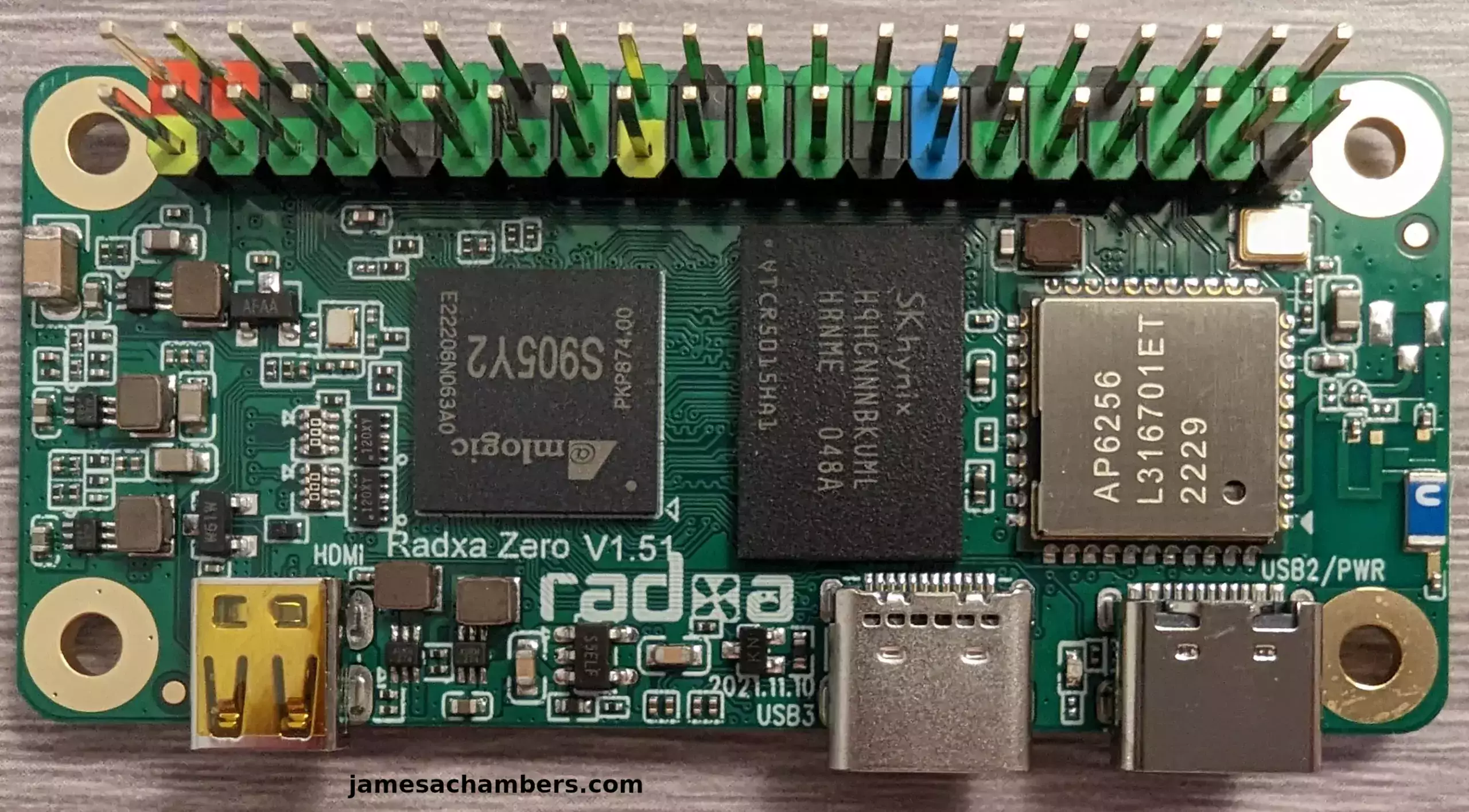
I received board revision V1.51. We can see the color-coded GPIO pins on the top here. All of the traces are clearly visible on the board.
You can also see that the Radxa Zero uses all USB-C! This is honestly what I expected the Raspberry Pi Zero 2W to look like. It’s very nice to see this instead of micro USB on the board.
There definitely isn’t as much to see on the bottom of the board:
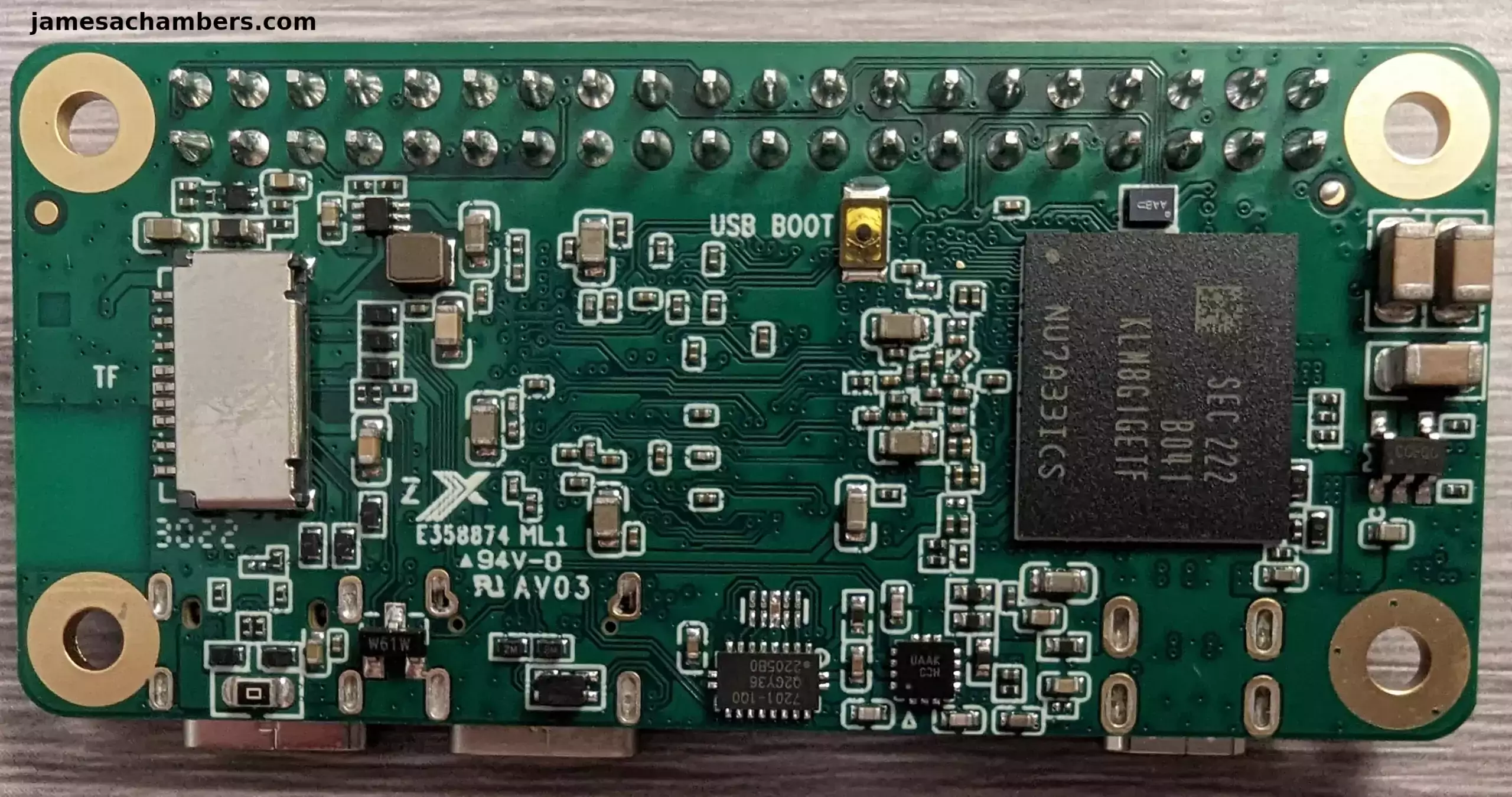
One notable thing on the bottom though is the SD card slot (labeled TF on the left hand side of the board).
Overall the build quality is excellent and I suspect the board will last a very long time.
Available Images
The official page to get images for the Radxa Zero is here. I however don’t recommend using it because all of those images are very old.
Instead I suggest using the official Radxa build GitHub release pages here which has much newer releases. These include the following:
- Armbian (Bullseye Minimal)
- Armbian (Focal XFCE Desktop)
- Debian (Buster XFCE)
- Ubuntu Server (Focal)
There are also the following third-party images available for the Radxa Zero:
This is a very healthy selection of images available. The board is well supported and there should be an image for just about everyone!
Testing Performance
You can verify the performance of your SSD on Pi Benchmarks using the following command:
sudo curl https://raw.githubusercontent.com/TheRemote/PiBenchmarks/master/Storage.sh | sudo bash
Here are the results:
Category Test Result
HDParm Disk Read 21.94 MB/s
HDParm Cached Disk Read 21.93 MB/s
DD Disk Write 17.1 MB/s
FIO 4k random read 1856 IOPS (7426 KB/s)
FIO 4k random write 955 IOPS (3821 KB/s)
IOZone 4k read 7476 KB/s
IOZone 4k write 2326 KB/s
IOZone 4k random read 6210 KB/s
IOZone 4k random write 3581 KB/s
Score: 1,049
The full Radxa Zero benchmark can be viewed here on Pi Benchmarks.
This performance puts it above the Raspberry Pi Zero and pretty close to the Raspberry Pi Zero 2W.
Pros / Cons
Pros
- A wide variety of eMMC and memory options are available
- Powerful quad-core CPU
- Includes USB-C (no micro USB!)
Cons
- Availability is pretty scarce even some time after release
Conclusion
I definitely understand why the Radxa Zero is so popular. It’s very powerful and feels like more of what I was expecting the Raspberry Pi Zero 2W to be. It’s very nice to be upgraded to USB-C. The quad-core CPU keeps pace pretty well with the Zero 2W as well.
Surprisingly the board seems to be available on Amazon in some European countries but there is no Amazon.com listing for it at time of writing. It’s pretty widely available on AliExpress though no matter where you are.
If you need a very small form factor or the form factor of a Raspberry Pi Zero this will be a fantastic alternative for people who can get away with not having to use Raspberry Pi OS. If you’re able to use Armbian / Debian / Ubuntu instead then it’s very likely you can use this alternative to the Raspberry Pi Zero 2W.
Cooling is definitely recommended. The copper heat sinks I recommend are great* but make sure you have something. The quad-core CPU is quite powerful and if you run it bare you’ll run into throttling and other issues a lot more frequently. It will perform better / smoother with a heat sink on it for sure.
This board is suitable for beginners. You don’t need to do any firmware flashing or anything fancy to get this one working. A USB to TTY serial console is not required with this board. You can plug it into a monitor and configure it that way. It also includes WiFi/Bluetooth capabilities which avoids having to try to buy an extra adapter for it.
Overall I’d recommend this board for anyone who needs a board in this form factor. The eMMC options are definitely worth considering as well as it’s nice to not have to worry about the SD card at all!
Other Resources
I’ve also reviewed the Radxa Rock 5B here
The Radxa Rock 4C+ is also worth considering for a much less expensive option than the Rock 5B that still supports NVMe
The Orange Pi portable monitor is a great choice to use with any SBC


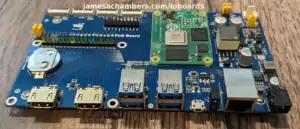
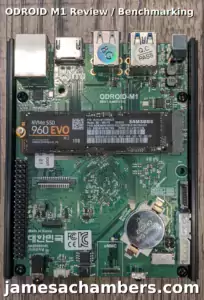

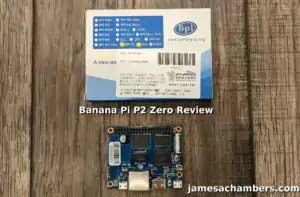
Hello,
I’m looking for a replacement to a RPi zero 2W for a project. I need this small form factor and this board seems good but I’m wondering if the GPIO are the same than for the original Raspberry.
For my project I want to use two cards :
– Pisugar2 for powering the board with battery
– Raspiaudio DAC : I need an analog mini jack audio out
So, do you know if the GPIO are the same ? And do you think that it could cause some software issues ?
Thanks,
Alain
Hey Alain,
So there are people that say the Pi Sugar does work on the Radxa Zero. They did not say the PiSugar 2 but they said RTC which the original Pi Sugar did not have so that must be what they mean. The original Pi Sugar doesn’t have a RTC (I have every version of it).
Still, the Radxa boards are a terrible choice for running Raspberry Pi hats. The problems you are going to have are several. First of all you can’t use overlays on the Radxa Zero. There’s no such thing. That’s going to be a dealbreaker for a lot of hats.
If you want to use Pi-specific hats you probably need to be using a Libre Computers board. Libre has a tool that lets you use overlays via a translation layer. You can even run Raspberry Pi OS.
As far as GPIO pinout compatibility the pins are the same but the addresses are different:
The header is the same, but the pin addresses are not, so if the software is using the rpi gpio library, you would need to rewrite those parts, and you’d need to make sure you’re using the correct addressesIn other words the libraries/code won’t be compatible without having their pin addresses changed. If you are expecting plug and play hats that is not going to happen on this board. Libre will probably give the smoothest experience if any hats are being considered.
For audio if you wanted to use something like an incredibly common USB to 3.5mm adapter. These have been plug and play for 10+ years (including on Linux). The Raspberry Pi hats won’t be. The Pi is a very proprietary device when it comes to stuff like that. Libre is the only manufacturer I know if that even attempts to really support Pi hats and the overlays associated with them.
Hopefully that helps!
What would you recommend as a replacement to the pi zero 2 W if my only requirement was the size? It doesn’t even need to be something with the same form factor.
Hey Willian,
Great question! I’d probably recommend the Radxa Zero or the Mango Pi MQ Quad given your requirements.
Hopefully that helps!
Great review, but you forgot to include TwisterOS on your review as shown under Radxa Zero download page
Hey notreallythatintotiktok,
Yes, I had that on the list but when I clicked the link it was broken. It’s working now though when I go to it so I will fix this in the article.
Thank you!
Thanks for sharing such a detailed review of this cool little board and I’m happy to see that they regularly update the Github page as its been a while since I set mine up and now I have an excuse to try something new with plenty of options to choose from!
I currently use mine as an arcade emulator and recommend cooling as the chip does get hot when under stress but otherwise its a strong recommend from me considering the price of an RPi Zero/Zero 2W on the after market and the lack of appeal from other competitors such as Banana Pi or Mango Pi that share the same form factor and general specs.
My only issue would be the small USB boot button as its super tiny as I managed to damage mine trying to flash the initial setup so user beware but besides that its easy to see why its so popular as the choice of added RAM and eMMC gives it the edge and I really hope Radxa reconsider their decision to postpone the Radxa Zero 2 as it really fills the missing gap between traditional SBCs and microcontrollers for what really is a repurposed Android TV box judging by the choice of chipset. Great job James!
Hey Razor Burn,
Thanks so much for sharing your experience with it! I definitely noticed the heat as well and I wasn’t surprised as I’ve seen this similar CPU on other boards before and knew it ran kind of hot. Most of the quad-core ARM alternatives to Broadcom seem to run pretty hot that I’ve seen. It does really well with some cooling on it for sure.
I completely agree on the lack of appeal of the other devices in the Pi Zero form factor for sure. I wanted to love all of those boards when I reviewed them. I do actually love this one though. This one is actually good enough / stable enough. I definitely wish they would update their main image page but that’s pretty minor compared to boards like Banana Pi where their latest image they are offering are things like Raspbian Stretch.
That’s a great warning about the tiny button. It’s actually really cool they got a button on here but it sounds like they would have benefited by using a more rugged/durable button. Which board revision did you have? I am all the way up to 1.51 on mine which is quite high up there relatively speaking for SBCs. One thing that wasn’t clear to me when covering this was the differences between some of the older revisions. It looks like there have been a *lot* of revisions of this board already. I know the wireless is something that has been changed a lot between the different revisions due to parts availability. It sounds like a strengthened button would be a nice choice for the next revision of this board. I also know there’s a Radxa Zero 2 coming down the pipe at some point here (and I think some people may have one already).
Thanks and take care!